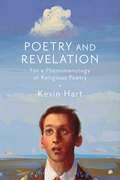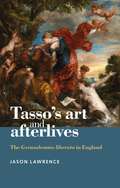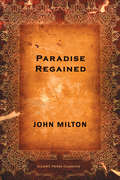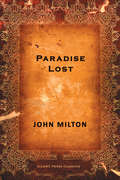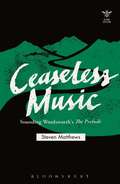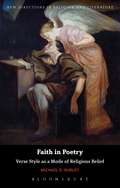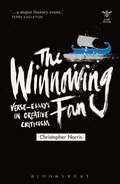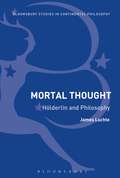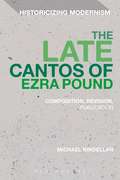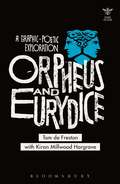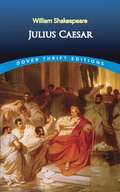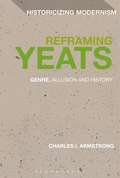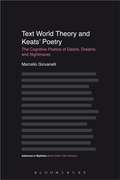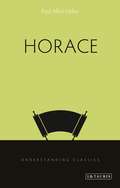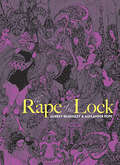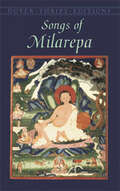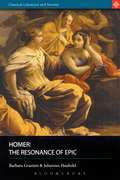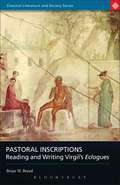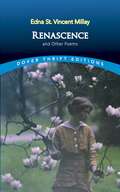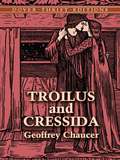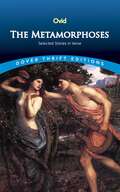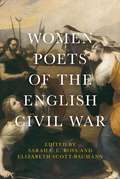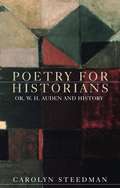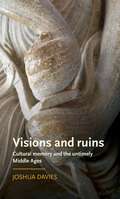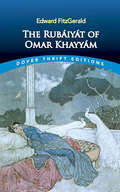- Table View
- List View
Poetry and Revelation: For a Phenomenology of Religious Poetry
by Kevin HartReligious poetry has often been regarded as minor poetry and dismissed in large part because poetry is taken to require direct experience; whereas religious poetry is taken to be based on faith, that is, on second or third hand experience. The best methods of thinking about "experience" are given to us by phenomenology. Poetry and Revelation is the first study of religious poetry through a phenomenological lens, one that works with the distinction between manifestation (in which everything is made manifest) and revelation (in which the mystery is re-veiled as well as revealed). Providing a phenomenological investigation of a wide range of “religious poems”, some medieval, some modern; some written in English, others written in European languages; some from America, some from Britain, and some from Australia, Kevin Hart provides a unique new way of thinking about religious poetry and the nature of revelation itself.
Tasso's art and afterlives: The <i>Gerusalemme liberata</i> in England
by Jason LawrenceTraces the impact of the great Italian poet’s neglected masterpiece across a broad spectrum of arts from the sixteenth to the late nineteenth centuries, focusing on, among many others, the works of Spenser, Milton, Shakespeare, Daniel, Van Dyck, Poussin, Handel and Byron.
Paradise Regained
by John MiltonPublished four years after Paradise Lost, Milton's epic, Paradise Regained, examines how everything lost to man is recaptured by the sacrifice of Christ.
Paradise Lost
by John MiltonJohn Milton's epic blank-verse poem depicts the Fall of Man, Satan's temptation of Adam and Eve in the Garden of Eden, and his ultimate expulsion from Heaven, as a result. Paradise Lost is heralded as one of the English's language's greatest poetic achievements.
Ceaseless Music: Sounding Wordsworth’s The Prelude (Beyond Criticism)
by Steven MatthewsThrough a series of poetic responses and critical reflections, Ceaseless Music explores the afterlives of Wordsworth's landmark autobiographical poem The Prelude in literature, philosophy and life writing, together with the insights it can offer into the writing of poetry today.Beginning with an exploration of the poem's genesis, from draft versions found in Wordsworth's notebooks onwards, the book goes on to sound out The Prelude's radical versions of selfhood through its attention to the 'musics' of place and of experience. The scope of the book ranges from biographical writings, to American literature and philosophy, neuroscience, musicology, and British and American poetries. The reader will discover new creative work in various modes, together with many re-echoings of Wordworth's text in later writers, across history, and from across the globe.
Faith in Poetry: Verse Style as a Mode of Religious Belief (New Directions in Religion and Literature)
by Michael D. HurleyIn this ambitious book, Michael D. Hurley explores how five great writers – William Blake, Alfred Tennyson, Christina Rossetti, Gerard Manley Hopkins, and T. S. Eliot – engaged their religious faith in poetry, with a view to asking why they chose that literary form in the first place. What did they believe poetry could say or do that other kinds of language or expression could not? And how might poetry itself operate as a unique mode of believing? These deep questions meet at the crossroads of poetics and metaphysics, and the writers considered here offer different answers. But these writers also collectively shed light on the interplay between literature and theology across the long nineteenth century, at a time when the authority and practice of both was being fiercely reimagined.
The Winnowing Fan: Verse-Essays in Creative Criticism (Beyond Criticism)
by Christopher NorrisThis path-breaking book explores different ways in which writing about poetry can deepen and extend our critical engagement by deploying creatively the manifold resources of poetic language and form. Through a series of verse-essays, reflective monologues, and inventive variations on topics in literary theory The Winnowing Fan makes a strong case for revising received ideas about the scope and limits of criticism.Norris's poems traverse the full range of European poetic history from Homer's Odyssey, through the work of French symbolists such as Mallarmé, to modern writers such as Yeats, Benjamin, Heaney, Larkin, and Barthes. There are also verse-essays and shorter pieces on philosophers from Hume and Leibniz to Heidegger, Althusser, Derrida, de Man, Rorty, Deleuze, Badiou, and Agamben. In each case Norris seeks to free criticism from conventional academic forms and return it to an active mutual engagement with the practice of literature itself.
Mortal Thought: Hölderlin and Philosophy (Bloomsbury Studies in Continental Philosophy)
by James LuchteMortal Thought seeks to illustrate the artistic and philosophical contexts for Hölderlin's poetic thought and to trace his profound impact upon subsequent philosophy, most notably Nietzsche, the Frankfurt School, Heidegger and Post-structuralism. Beginning with the point of departure of Hölderlin in Kant and Fichte, Mortal Thought outlines the novel philosophical innovations of Hölderlin, and their influence upon philosophy from the 19th century to the present day. A renewed appreciation of Hölderlin will allow us to retrieve an authentic philosophy for our own era. Mortal Thought lays out a concise, clear and comprehensive account of the emergence of Hölderlin as philosopher and poet, of his influence upon the four dominant strands of Continental philosophy - Nietzsche, Heidegger, Critical Theory and Poet-structuralism - and of his relevance for us in our own era.
The Late Cantos of Ezra Pound: Composition, Revision, Publication (Historicizing Modernism)
by Michael KindellanDrawing extensively on archival research, The Late Cantos of Ezra Pound critically explores the textual history of Pound's late verse, namely Section: Rock-Drill (1955) and Thrones (1959). Examining unpublished letters, draft manuscripts and other prepublication material, this book addresses the composition, revision and dissemination of these difficult texts in order to shed new light on their significance to Pound's wider project, his methods and techniques, and the structures of authority-literary and political-that govern the meaning of his poetry. Illustrated by reproductions of archival documents, The Late Cantos of Ezra Pound is an innovative new study of one of the most important poets of the 20th century.
Orpheus and Eurydice: A Graphic-Poetic Exploration (Beyond Criticism)
by Tom De Freston Kiran Millwood HargraveThe story of Orpheus's tragic quest into the underworld to rescue his true love Eurydice back from the dead is one that has haunted the western imagination for over 2,000 years through many tellings, re-tellings, appropriations and adaptations.A unique coming together of poetry, art and criticism, Orpheus and Eurydice explores the myth's impact through a graphic-poetic reconstruction of the story. Including critical reflections from leading thinkers, writers and critics, this is a compelling exploration of the enduring power of this tale.
Julius Caesar: Downloadable Response Journal
by William ShakespeareBased on Plutarch's account of the lives of Brutus, Julius Caesar, and Mark Antony, Julius Caesar was the first of Shakespeare's Roman history plays. Presented for the first time in 1599, the play reveals the great dramatist's consummate ability to explore and express the most profound human emotions and instincts. So clearly and urgently does it impact its insights into history and human behavior, Julius Caesar is traditionally among the first of Shakespeare's plays to be studied at the secondary-school level.In addition to its compelling insights into the human condition, Julius Caesar is also superb drama, as Brutus, Cassius, and the other conspirators hatch a plot to overthrow Caesar, dictator of Rome. After Caesar is assassinated, Mark Antony cleverly turns the crowd against the conspirators in one of the most famous speeches in literature. In the civil war that follows, the forces of Mark Antony and Octavius Caesar eventually win out over the armies of Cassius and Brutus. Humiliated and desperate, both conspirators choose to end their lives. These tragic events unfold in a riveting dramatic spectacle that also raises profound questions about power, government, ethics, and loyalty.Now this great tragedy is available in this inexpensive edition, complete and unabridged with explanatory footnotes.
Reframing Yeats: Genre, Allusion and History (Historicizing Modernism)
by Charles I. ArmstrongReframing Yeats, the first critical study of its kind, traces the historical development of W. B. Yeats's writings across the genres, examining his poetry, autobiographical writings, criticism, and drama with the same critical analysis. While existing studies of Yeats's work choose between a biographical orientation or a formalist approach, Armstrong's study combines the theory of New Historicism and Hermeneutics: a theoretical approach that takes Yeatsian scholarship one step further. Grounded in history and informed by recent studies, this innovative approach presents new interpretations and understandings of Yeats's texts. As well as providing a fresh reading of "Among School Children" and situating his autobiographical writings in relation to preceding Victorian practices and contemporary experimentation, this groundbreaking work documents some of the most important existing readings of Yeats's relationship to history, Modernism and the literary genres.
Text World Theory and Keats' Poetry: The Cognitive Poetics of Desire, Dreams and Nightmares (Advances in Stylistics)
by Marcello GiovanelliText World Theory and Keats' Poetry applies advances in cognitive poetics and text world theory to four poems by the nineteenth century poet John Keats. It takes the existing text world theory as a starting point and draws on stylistics, literary theory, cognitive linguistics, cognitive psychology and dream theories to explore reading poems in the light of their emphasis on states of desire, dreaming and nightmares. It accounts for the representation of these states and the ways in which they are likely to be processed, monitored and understood. Text World Theory and Keats' Poetry advances both the current field of cognitive stylistics but also analyses Keats in a way that offers new insights into his poetry. It is of interest to stylisticians and those in literary studies.
Horace (Understanding Classics)
by Paul Allen MillerPerhaps no classical writer has been so consistently in vogue as Horace. Famous in his own lifetime as a close associate of the Emperor Octavian, to whom he dedicated several odes, Quintus Horatius Flaccus (65–8 BC) has never really been out of fashion. Petrarch, for example, modelled his letters on Horace's innovative Epistles, while also borrowing from his Roman forebear in composing his own Italian sonnets. The echo of Horace's voice can be found in almost every genre of medieval literature. And in later periods, this influence and popularity if anything increased. Yet, as Paul Allen Miller shows, while Horace may justifiably be called the poet for all seasons he is also in the end an enigma. His elusive, ironic contrariness is perhaps the true secret of his success. A cultured man of letters, he fought on the losing side of the Battle of Philippi (42 BC). A staunch Republican, he ended up eagerly (some said too eagerly) promoting the cause of Julio-Claudian imperialism. Viewed as the acme of Roman literary civilization, he was shaped by his Athens education at Plato's famous Academy. This new introduction reveals Horace in all his paradoxical genius and complexity.
The Rape of the Lock: An Heroi-comical Poem... (Dover Fine Art, History Of Art Series)
by Alexander Pope Aubrey BeardsleyOnly rarely in publishing history has the ideal edition of a literary work been created, where text, typography, and illustrations complement one another perfectly. Among the few examples are the Kelmscott Chaucer, Baskerville's Milton, and Beardsley's Salome. Another such book is the 1896 edition of Pope's The Rape of the Lock, illustrated by Aubrey Beardsley.Beardsley's elaborate drawings for The Rape of the Lock were created during the last phase of his brief career. This nearly Romantic period, characterized by rich, brilliantly imagined decoration and ornamentation and by high textual contrasts, was perfectly suited to the blend of mock-heroic, satire, and delicate fancy of Pope's poems. As Beardsley's biographer R. A. Walker wrote, "These drawings show a verve, a wit and appreciation of the poem than can scarcely be matched in English literature." Using his unique line and "black blot" technique, Beardsley created a masterpiece of design and mood.This Dover edition reproduces the first edition: the complete text of the five-canto poem, notes, seven full-page drawings, two half-page drawings, and the original cover design by Beardsley.
Songs of Milarepa (Dover Thrift Editions)
by MilarepaA Buddhist holy man whose songs have been sung and studied since the twelfth century, Milarepa exchanged a life of sin and maliciousness for one of contemplation and love, eventually reaching—according to his disciples—the ultimate state of enlightenment. His thousands of extemporaneously composed songs communicate complex ideas in a simple, lucid style. This volume features the religious leader's best and most highly esteemed songs of love and compassion. Sure to inspire and provide reading pleasure to a wide audience.Considered by many of his followers to be another St. Francis, Milarepa exchanged a life of sin and maliciousness for one of contemplation and love, eventually reaching a state of enlightenment. His thousands of extemporaneously composed songs have been widely sung and studied since they were first recorded and disseminated centuries ago by his disciples. This volume features the best and most highly esteemed of the religious leader's songs of love and compassion that include lessons on the negative aspects of ambition and the importance of finding inner peace. In addition, he stresses the briefness of life: ". . . so apply yourself to meditation. Avoid doing evil, and acquire merit, to the best of your ability, even at the cost of life itself. In short: Act so that you have no cause to be ashamed of yourselves and hold fast to this rule."
Homer: The Resonance of Epic (Classical Literature and Society)
by Barbara Graziosi Johannes HauboldThis book offers a new approach to the study of Homeric epic by combining ancient Greek perceptions of Homer with up-to-date scholarship on traditional poetry. Part I argues that, in the archaic period, the Greeks saw the lliad and Odyssey neither as literary works in the modern sense nor as the products of oral poetry. Instead, they regarded them as belonging to a much wider history of the divine cosmos, whose structures and themes are reflected in the resonant patterns of Homer's traditional language and narrative techniques. Part II illustrates this claim by looking at some central aspects of the Homeric poems: the gods and fate, gender and society, death, fame and poetry. Each section shows how the patterns and preoccupations of Homeric storytelling reflect a historical vision that encompasses the making of the universe, from its beginnings when Heaven mated with Earth, to the present day.
Pastoral Inscriptions: Reading and Writing Virgil's Eclogues (Classical Literature and Society)
by Brian W BreedVirgil's "Eclogues" represent the introduction of a new genre, pastoral, to Latin literature. Generic markers of pastoral in the "Eclogues" include not only the representation of the singing and speaking of shepherd characters, but also the learned density of the text itself. Here, Brian W. Breed examines the tension between representations of orality in Virgil's pastoral world and the intense textuality of his pastoral poetry. The book argues that separation between speakers and their language in the "Eclogues" is not merely pastoral preciosity. Rather, it shows how Virgil uses representations of orality as the point of comparison for measuring both the capacity and the limitations of the "Eclogues" as a written text that will be encountered by reading audiences. The importance of genre is considered both in terms of how pastoral might be defined for the particular literary-historical moment in which Virgil was writing and in light of the subsequent European pastoral tradition.
Renascence and Other Poems (Dover Thrift Editions)
by Edna St. MillayThe poems of Edna St. Vincent Millay (1892–1950) have been long admired for the lyric beauty that is especially characteristic of her early works. "Renascence," the first of her poems to bring her public acclaim, was written when she was nineteen. Now one of the best-known American poems, it is a fervent and moving account of spiritual rebirth.In 1917, "Renascence" was incorporated into her first volume of poetry, which is reprinted here, complete and unabridged, from the original edition. The 23 works in this first volume are fired with the romantic and independent spirit of youth that Edna St. Vincent Millay came to personify. In addition to "Renascence," this volume includes 16 other early lyric poems — "Interim," "Sorrow," "Ashes of Life," "Three Songs of Shattering," "The Dream," "When the Year Grows Old," and others, including six sonnets, to which Millay brought great distinction throughout her career.
Troilus and Cressida: Rendered into Modern English Verse (Dover Thrift Editions)
by Geoffrey ChaucerFrequently referred to as the first great English novel, this story of two lovers brims with romance, warfare, and betrayal. Set during the siege of Troy, the epic poem tells of Troilus, a Trojan prince who has fallen hopelessly in love with Cressida, the daughter of a Trojan priest who has defected to the Greeks.Remarkable for his beauty and bravery, Troilus is an engaging youth--noble, sensitive, and pure-souled--who lives, and eventually dies, for Cressida, a virtuous, tenderhearted young woman driven to infidelity by circumstance.Regarded by many as Chaucer's most noble work of art, Troilus and Cressida has long been praised by critics as the most perfect of his completed works. The volume is an outstanding choice for readers of mythology and medieval poetry.
The Metamorphoses: Selected Stories in Verse (Dover Thrift Editions)
by OvidOne of ancient Rome's most celebrated poets, Ovid (43 B.C.–A.D. 18) wrote during the reign of Augustus. His works reflect a sentiment of art for pleasure's sake, without the ethical or moral overtones, which perhaps accounts for his enduring popularity. For more than two thousand years, readers have delighted in Ovid's playful eloquence; his influence on other writers has ranged from Dante and Chaucer to Shakespeare and Milton, and scenes from his stories have inspired many great works by Western artists.This selection of thirty stories from the verse translation by F. A. Wright of Ovid's famous work, The Metamorphoses, does full justice to the poet's elegance and wit. All of the tales involve a form of metamorphosis, or transformation, and are peopled by mythological gods, demigods, and mortals: Venus and Adonis, Pygmalion, Apollo and Daphne, Narcissus, Perseus, and Andromeda, Orpheus and Eurydice, the Cyclops, and Circe, among others.Although most of the stories did not originate with Ovid, it is quite possible that had he not written them down, these oral traditions would have been lost forever — and with them, a vast and valuable amount of Greco-Roman culture. This collection of the poet's best and most beloved narrative verses reflects the vitality of classical mythology. A selection of the Common Core State Standards Initiative.
Women poets of the English Civil War (Current Practices in Ophthalmology)
by Sarah C. RossFeaturing modernised spelling and detailed explanatory notes, this anthology of Civil War-era women poets is perfect for students of English literature and early modern studies.
Poetry for historians: Or, W. H. Auden and history
by Carolyn SteedmanWhat is the point of poetry for historians? The answer lies in this new 'history of history', which looks at the question through the prism of W. H. Auden’s Cold War history poems and of poetry and history education from the eighteenth century to the present day.
Visions and ruins: Cultural memory and the untimely Middle Ages (G - Reference, Information and Interdisciplinary Subjects)
by Joshua DaviesThis study works with texts in Old English, Middle English and Latin, as well as material and visual culture, to explore how representations of the past created in the British Middle Ages have been reimagined in modernity.
The Rubáiyát of Omar Khayyám: First and Fifth Editions (Dover Thrift Editions)
by Edward FitzGeraldOmar Khayyám (1048–1122) was a Persian mathematician, astronomer, and a philosopher who was not known as a poet in his lifetime. Later, a body of quatrains became attached to his name, although not all were his works. These verses lay in obscurity until 1859, when Edward FitzGerald (1809–1883), an English country gentleman, published a free adaptation of this Persian poetry. After its discovery by D. G. Rossetti and others, the verse became extremely popular. Essentially a hedonist and a skeptic, Omar Khayyám, through FitzGerald, spoke with both an earthy and spiritual freedom that stirred a universal response. As a result, the Rubáiyát became one of the best-known and most often quoted English classics. The fifth edition, published posthumously in 1889, was based on FitzGerald's handwritten changes in a copy of the fourth edition, and is traditionally printed with the first edition.
